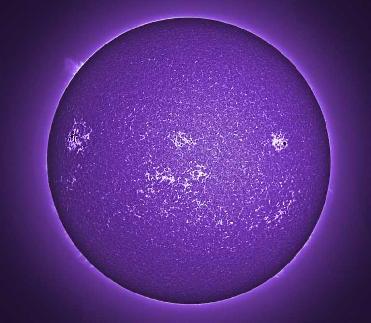
The glowing white magnetic network is what gives the sun its extra oblateness during times of high solar activity
WASHINGTON (BNS): The Sun is not the perfect round ball of fire that we imagine it to be. Scientists using NASA’s RHESSI spacecraft have measured the roundness of the sun with unprecedented precision. And they found that it is not a perfect sphere.
During years of high solar activity the sun develops a thin “cantaloupe skin” that significantly increases its apparent oblateness, its equatorial radius becomes slightly larger than its polar radius.
“The sun is the biggest and therefore smoothest object in the solar system, perfect at the 0.001% level because of its extremely strong gravity,” says study co-author Hugh Hudson of UC Berkeley. “Measuring its exact shape is no easy task.”
The team accomplished the task by analyzing data from the Reuven Ramaty High-Energy Solar Spectroscopic Imager, RHESSI for short, and an x-ray/gamma-ray space telescope launched in 2002 on a mission to study solar flares.
Although RHESSI was never intended to measure the roundness of the sun, it has turned out ideal for the purpose.
“We have found that the surface of the sun has rough structure: bright ridges arranged in a network pattern, as on the surface of a cantaloupe but much more subtle,” describes Hudson. During active phases of the solar cycle, these ridges emerge around the sun’s equator, brightening and fattening the “stellar waist.”
”At times a very small angle, is in fact quite significant,” says Alexei Pevtsov, RHESSI Program Scientist at NASA Headquarters.
Tiny departures from perfect roundness can, for example, affect the sun’s gravitational pull on Mercury and skew tests of Einstein’s theory of relativity that depend on careful measurements of the inner planet’s orbit. Small bulges are also telltale signs of hidden motions inside the sun. For instance, if the sun had a rapidly rotating core left over from early stages of star formation, and if that core were tilted with respect to its outer layers, the result would be surface bulging.
The “cantaloupe ridges” are magnetic in nature. They outline giant, bubbling convection cells on the surface of the sun called “supergranules.” Supergranules are like bubbles in a pot of boiling water amplified to the scale of a star; on the sun they measure some 30,000 km across (twice as wide as Earth) and are made of seething hot magnetized plasma.
Magnetic fields at the center of these bubbles are swept out to the edge where they form ridges of magnetism. The ridges are most prominent during years around Solar Max when the sun’s inner dynamo “revs up” to produce the strongest magnetic fields. Solar physicists have known about super granules and the magnetic network they produce for many years, but only now has RHESSI revealed their unexpected connection to the sun’s oblateness.
 Previous Article
Previous Article Next Article
Next Article













The Indian Air Force, in its flight trials evaluation report submitted before the Defence Ministry l..
view articleAn insight into the Medium Multi-Role Combat Aircraft competition...
view articleSky enthusiasts can now spot the International Space Station (ISS) commanded by Indian-American astr..
view article